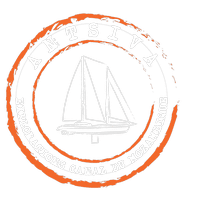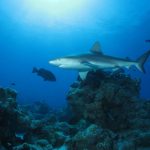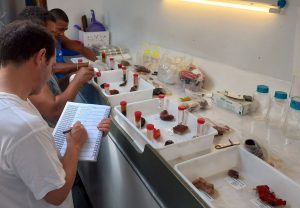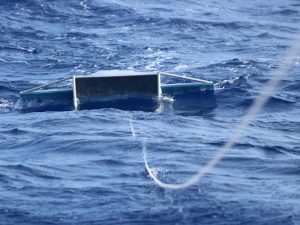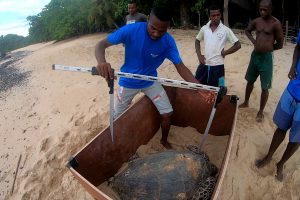Reportage
Scientific Mission Barrens Islands - Study of Sharks and Cetaceans
And here we go for a new mission aboard Antsiva with a new team of scientists
400 nautical miles and 3 days of sailing before reaching the Barens Islands.
On the road, an engine stop is planned to allow Salvatore to deploy a hydrophone. The location is 40 miles off Cape St Andrew at the edge of the continental shelf. We arrive at night at the point of deployment. The device is sent by 30m depth and will record continuously the sound of all cetaceans in the area. It will be recovered in 8 days, during our return passage.
During navigation, the Cetaceans team does not leave the bridge, in observation and in note-taking. Observation requires special attention. Most of them scan the horizon with binoculars, others post at the front of the boat and watch the horizon, but some have a very personal way of looking at the sea, they are called dancing brothers.
And the navigation continues, everyone finds his rhythm and his occupations. In addition to the observations on the bridge, there is reading, computer work, preparation of equipment and the latest developments, there is the sound of the bell on the edge that always announces the lunch breaks without forgetting the moments of relaxing around a sunset aperitif.
We arrive at the Barrens at the end of the 3rdth day and the following morning, the BRUVS team is hard at work. Jordan sets up the cameras, Tahina goes snorkeling in the freezer to take out the 12 packets of sardines that will serve as bait. Meanwhile, on the deck the crew prepares the annex which will serve as a logistic means for the deployment of the bruvs. And here we go, for a tour of the Bruvs, a total of 6 stations are deployed to repeat 2 to 3 times in the day, up to 18 deployments.
It is a structure equipped with a stereo video system and an arm at the end of which we hang a bait. During this mission, the Bruvs will be used to record and analyze the behavior of predators and sharks in particular.
But let's see how a typical day goes for the Bruvs team.
Once the deployment waypoints are determined, Jordan installs the cameras on the stations, then sets the arm and the grid that Chrystelle has previously filled with sardines And hop, we balance everything in the sea and we watch that the descent is done without problem. Once the 6 stations deployed on the same area, you have to wait an hour ... it's sometimes a bit long .... But good after an hour, action, we return to the buoys of each station and we go back the BRUVS. Once the 6 stations are reassembled, a new exploration zone is determined for a new deployment.
And in the evening, after a day of effort, waiting and sun, Jordan and Marc perform a first quick view of the recordings of the day.
Since the Barrens mission is a multidisciplinary mission, let's see what other team members are doing.
In complementarity of BRUVS recordings, two other types of data will be studied: habitats and environmental genetics.
To map habitats associated with the Bruv area, two divers will transect using a stereo video camera system. This method allows you to go much faster, cover a much larger area and instantly have an overall view of the habitat.
The second aspect studied in association with the Bruvs data will be the study of environmental DNA.
All living organisms leave in the environments they frequent traces of DNA that testify to their present or past presence. In this case, the goal is to detect traces of shark DNA left in the environment.
After sampling, the water is immediately filtered on the boat. The filtration is carried out through a membrane that retains the cells and mitochondria released by the sharks. The membranes are then frozen on board and the samples will be sent to the laboratory for analysis.
On the cetaceans side, even at anchor, observations are continuing on the second appendage. In addition to classic visual observations and photo identification, Salvatore will perform biopsies on dolphins. This manipulation involves collecting small pieces of skins using darts fired with an airgun. Salvatore and Tahina then go to the chase, the first equipped with a rifle, the second with his camera will both shoot the dolphins
The Barren Islands archipelago of 9 islands is located southwest of the town of Maintirano. Due to lack of fresh water, these islets are not inhabited but some are home to traditional fishing camps. They can stay there for 9 months from March to November.
Jérémy is anxious to share with these nomadic local communities and each stopover is the subject of an exchange with the fishing families. We bring them freshwater jerrycans and they bring us information about their environment, the presence of species of sharks and cetaceans and the products of their fishing. The villages consist of basic huts and have large fish driers on which there are also many sharks and rays. Jérémy then takes flesh samples for genetic analysis.
The Barrens is an area very rich in marine biodiversity. Regularly, these fishermen go to Maintirano to sell their catch, bring in fresh water and buy the necessities. For all these populations, which represent a total of more than 4,000 fishermen, the exploitation of the sea remains their only source of income.
A new fisheries management model to promote human rights and protect fishing grounds has been developed by WWF Madagascar and is managed by the NGO BlueVenture
This mission on the Barren Islands is coming to an end. We thank all the team for sharing with us their knowledge, interest and passion.
